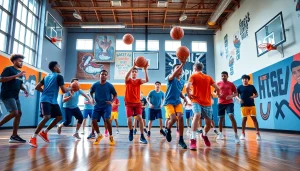Unforgettable Halftime Moments: The Allure of Spectacular Performances

The Significance of Halftime in Sports
In the world of sports, halftime transcends the mere pause between two halves of a game. It is a cultural phenomenon that stitches together entertainment, marketing, and social engagement. This pivotal moment has evolved significantly over the years and has become synonymous with major sporting events, especially the Super Bowl. As fans gather around their screens to witness critical gameplays, they also look forward to a unique blend of music, spectacle, and emotional experience that halftime shows deliver. Teams, artists, and brands recognize the value of halftime as a potent opportunity to connect with audiences on various levels.
a. Cultural Impact of Halftime Shows
Halftime shows have morphed into cultural touchstones that reflect societal values, trends, and movements. They act as platforms for artists to showcase their talents to a massive audience, solidifying their place in the cultural zeitgeist. From the iconic performances of Michael Jackson and Prince to the recent shows headlined by artists such as Shakira and Jennifer Lopez, halftime acts have the power to spark conversations that extend far beyond the field. These performances often blend music with visual arts, choreography, and technology, creating an immersive experience that resonates with diverse audiences.
b. Historical Evolution of Halftime Performances
The concept of halftime shows dates back to the early days of American football, primarily featuring marching bands and college performances. However, the format has transformed dramatically over the decades. The Super Bowl, in particular, revolutionized halftime entertainment in the 1990s when it began to feature high-profile artists instead of traditional bands. This change reflected a growing acknowledgment of the halftime space as an essential marketing opportunity, allowing advertisers and brands to reach millions in one shot.
c. Halftime as a Marketing Opportunity
As halftime shows gain popularity, they also present lucrative marketing opportunities for brands. Companies increasingly see the halftime slot as an avenue for product launches, major announcements, and engaging advertisements. The potential reach is immense, with viewership often surpassing the game itself. This value drives partnerships between major brands, artists, and event organizers aiming to craft memorable experiences that captivate audiences. For instance, commercials aired during the Super Bowl have become as anticipated as the game, with brands pulling out all stops to create memorable and impactful messages.
Iconic Halftime Shows Over the Years
The realm of halftime shows is steeped in unforgettable performances that have defined generations of entertainment. Artists leverage this platform to connect with audiences, invoke nostalgia, and create moments that become etched in the annals of pop culture.
a. Notable Performers and Their Impact
Artists such as Beyoncé, Justin Timberlake, and Lady Gaga have all headlined halftime shows that not only showcased their talents but made strong cultural statements. Beyoncé’s performance in 2016, for instance, addressed themes of empowerment and unity, reflecting social movements prevalent at the time. Similarly, Shakira and Jennifer Lopez’s shared performance in 2020 emphasized Latina culture and representation, earning acclaim for its vibrant celebration of heritage. Each performer brings their unique flair, significantly shaping how halftime shows are perceived and experienced by audiences worldwide.
b. Memorable Moments in Super Bowl History
Halftime shows are often a canvas for poignant moments. From Janet Jackson’s infamous wardrobe malfunction in 2004 to the emotional tribute to medical personnel during The Weeknd’s performance in 2021, these performances can evoke myriad emotions and conversations. Such moments often lead to public discourse, drawing attention to broader societal issues, thus highlighting the intersection of sports, arts, and social commentary.
c. The Evolution of Entertainment During Halftime
The evolution of halftime shows reflects changing audience tastes and technological advancements. The blending of different art forms, use of cutting-edge technology, and integration of diverse cultural elements have resulted in performances that are spectacles in their own right. Today, artists utilize immersive experiences like augmented reality (AR) and elaborate stage designs that enhance audience engagement, both live and in front of television screens.
Behind the Scenes of Halftime Productions
The spectacle witnessed during halftime is not solely the result of raw talent; it requires intricate planning and a cohesive team effort. Understanding the logistics behind these productions unveils the complexity involved in creating seamless performances.
a. Logistics and Planning for Major Events
The planning of a halftime show often begins months in advance and involves coordination among artists, production crews, sound engineers, and event organizers. For example, the production team needs to cater to different aspects such as staging, light design, sound checks, and more. The logistics of transporting equipment and setting up within a limited time window post-first half is a challenging task that requires meticulous planning and execution.
b. The Role of Sound and Lighting in Performance
Sound and lighting play vital roles in shaping how an audience experiences a halftime show. Sound engineers painstakingly configure audio systems to ensure optimal quality; meanwhile, sophisticated lighting designs help elevate performances to captivating visual spectacles. Technology’s evolution has introduced innovative ways to artistic expression, such as automated lighting systems and synchronized pyrotechnics, which enhance the overall sensory experience.
c. Challenges Faced by Halftime Coordinators
Coordinating a halftime show also comes with its share of challenges. From dealing with last-minute changes, including artist availability to technical glitches, the pressure is undeniably high. Weather conditions can also impact outdoor events. For instance, unanticipated rainfall during a live performance can hinder operations, requiring pre-planned contingencies to be executed quickly. Successful halftime coordinators learn to anticipate potential hurdles and have strategies in place to address them promptly.
Fan Perspectives on Halftime Experiences
As cultural phenomena, halftime shows have garnered intense interest and engagement from fans, making their perspectives valuable in refining future performances.
a. Engaging the Audience During Halftime
Engagement strategies during halftime are crucial. Spectators look for excitement, nostalgia, and a connection to the performers. Interactivity is gaining ground, especially with platforms that integrate live voting for song choices or the inclusion of celebrity cameos that resonate with the audience. Engaging fans effectively enhances their event experience and offers memorable takeaways.
b. Surveys and Polls: What Fans Prefer
Conducting surveys regarding halftime shows provides insights into fan preferences. Common findings reveal that audiences enjoy a mix of renowned performers, nostalgic elements, and high-energy performances. For instance, polls conducted in recent years consistently rank shows with thematic elements (e.g., tributes to cultural movements) higher than others. This feedback loop is vital for future planning, offering organizers a clearer picture of what resonates with fans.
c. Social Media Reactions to Halftime Shows
The rise of social media has transformed how halftime shows are consumed and discussed. Platforms like Twitter and Instagram become hubs for real-time reactions, allowing fans to share opinions instantaneously. These interactions influence public perception of the event and can impact subsequent performances. Artists and event organizers often analyze these social reactions to gauge fan sentiment and learn from successes or failures.
Future Trends in Halftime Entertainment
As the world of halftime entertainment continues to evolve, new trends emerge that signal exciting changes in how these performances are conceived and executed.
a. Technology’s Role in Shaping Halftime
The integration of technology into halftime shows is likely to become even more prominent. Innovations in augmented reality, virtual reality experiences, and interactive broadcasts can create unprecedented engagement. Future shows may allow fans to participate in unique ways, bridging the gap between physical and digital experiences.
b. Potential Collaborations and Innovations
We may see interesting collaborations that blend traditional genres with modern styles. The union of various artistic disciplines—music, visual effects, fashion, and dance—could give rise to groundbreaking performances that redefine audience expectations. This kind of innovation can breathe fresh life into halftime shows, attracting diverse demographics and widening the appeal of live sports entertainment.
c. Speculations for Upcoming Super Bowl Halftime Performances
With artists becoming more involved in social issues, future Super Bowl halftime shows may heavily draw from current events or cultural movements, crafting narratives that resonate with a broad audience. As expectations shift from mere entertainment to meaningful cultural commentary, future performances could mark a new frontier where artistry and message coexist harmoniously. This evolving landscape presents exciting opportunities for performers and an enriched experience for fans.







